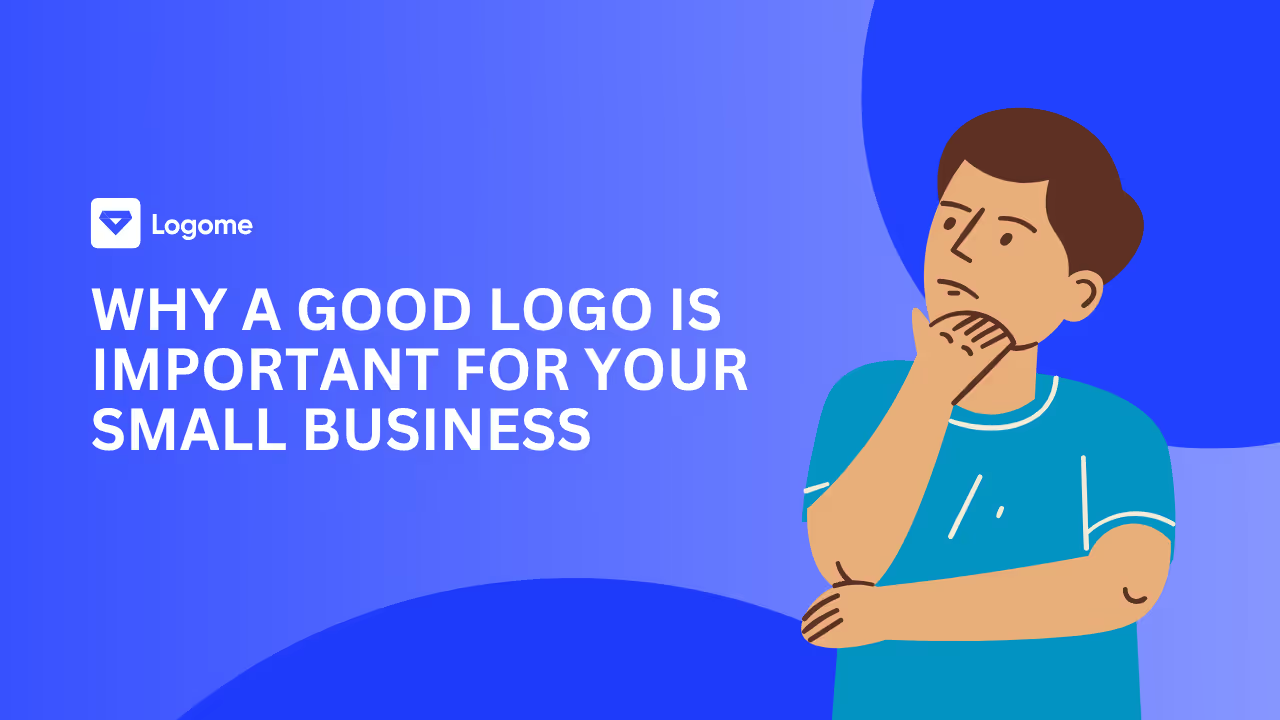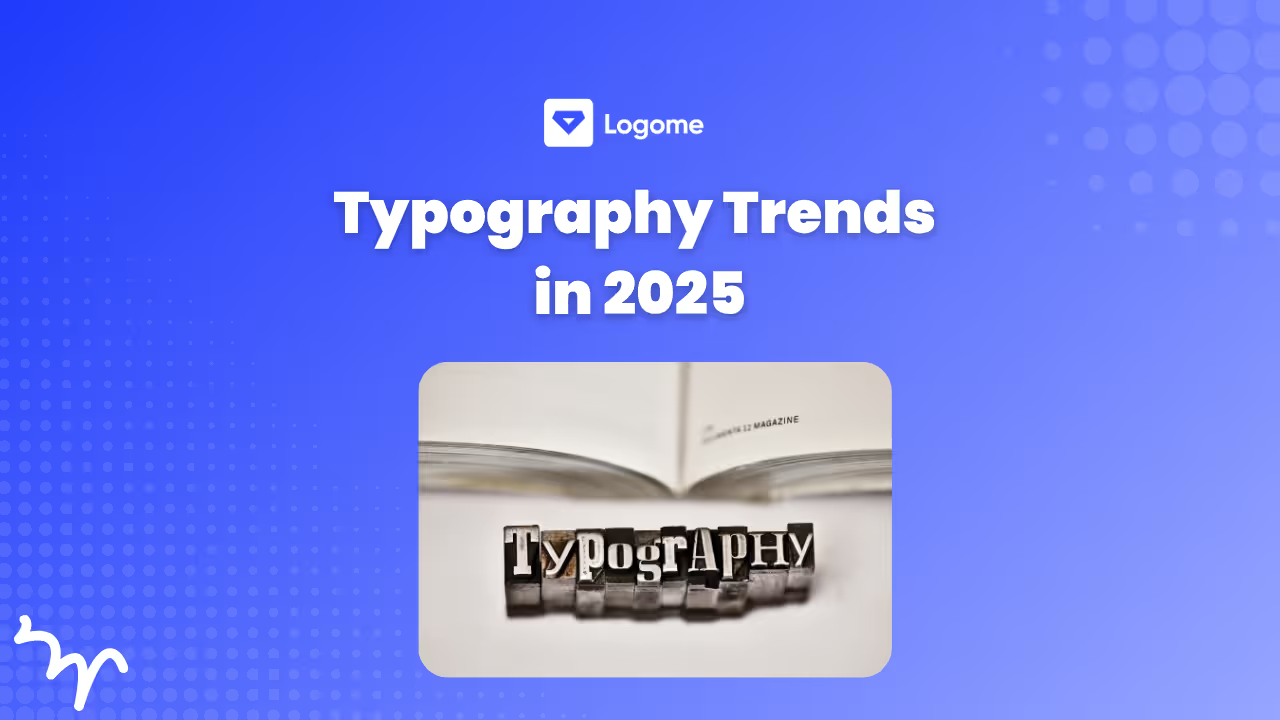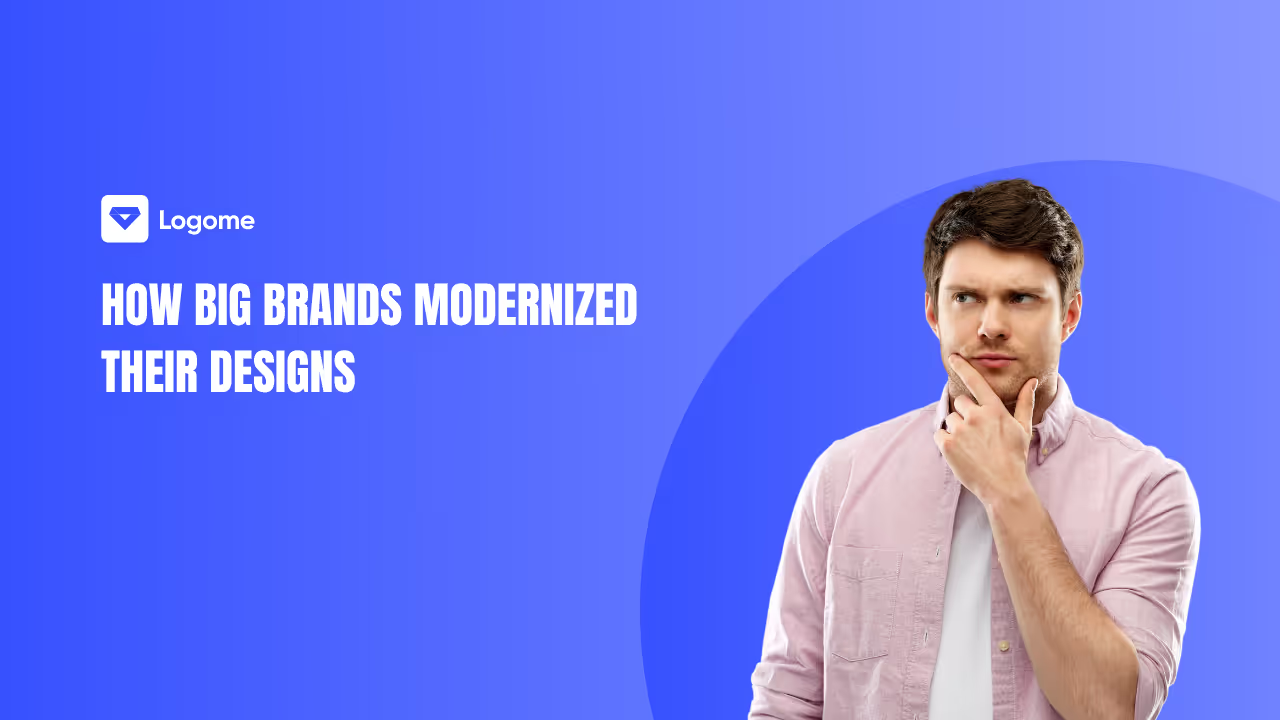Why A Good Logo Is Important For Your Small Business
Discover why a good logo is important for your small business. Learn how logos build brand identity, trust, and recognition—plus expert tips on logo creation.
Discover why a good logo is important for your small business. Learn how logos build brand identity, trust, and recognition—plus expert tips on logo creation.

Think about the brands you love—Apple, Nike, Starbucks. What’s the first thing that comes to mind? The logo. It’s not just a design; it’s the face of the brand. If you're running a small business, your logo isn’t just important—it’s essential.
Your logo tells people who you are, what you do, and what you stand for. It builds recognition, trust, and sets the tone for your entire brand identity. In this blog, we break down the importance of a logo for small business—from design tips to real stats—to help you get it right the first time.
Let’s make your brand unforgettable.
Let’s start with the basics—what a logo is and why it’s crucial, especially if you're running a small business. Many new entrepreneurs treat logos as an afterthought. But in reality, a logo can make or break how your audience perceives you.
A good logo gives your business a face. It tells your story in a single glance. It creates instant brand recognition, builds credibility, and connects your audience to your values.
Now, let’s dig deeper into the importance of a logo for small business and why it’s more than just a pretty design.
A logo is the visual identity of your business. It combines elements like colors, fonts, icons, and layouts to represent your brand.
Think of it as your business’s signature. Whether it’s a simple wordmark like Coca-Cola or an abstract symbol like Pepsi, your logo is what people remember. And that memory influences how they feel about your brand.
Your logo is the foundation of your visual branding.
From your website and business cards to product packaging and social media, your logo ties everything together. It keeps your branding consistent, which is key to gaining trust.
Studies by Lucidpress show that consistent brand presentation across all platforms increases revenue by up to 23%. Your logo is the tool that makes that consistency possible.
If your visuals look scattered or unprofessional, people won’t take your business seriously—especially in the first interaction.
Big brands already have awareness. Small businesses don’t. That’s why your logo does the heavy lifting.
Here’s what a strong logo does for your small business:
In fact, 50% of consumers say a brand’s logo is the first thing they notice, and 60% will avoid a brand with an unappealing or outdated logo.
That’s a clear signal: your logo isn’t just a graphic—it’s a business asset.
Your logo does more than sit at the top of your website. It plays a powerful role in how people see, remember, and trust your brand. Especially for small businesses, the right logo can make a big difference in how you’re perceived.
Let’s break down the top five reasons why a good logo is a must—not a maybe.
You only get a few seconds to make someone stop scrolling or scanning. A well-designed logo catches the eye immediately.
A recent study by Missouri University of Science and Technology found that users spend just 6.48 seconds looking at a brand logo when they land on a website. That’s your window to spark curiosity.
Think of your logo as your handshake—it needs to be firm, clean, and confident.
First impressions matter. A good logo helps you make a strong one.
Consumers form opinions about a brand within 10 seconds.. If your logo looks outdated or unclear, they might assume the same about your business.
Your logo is the first visual cue people see—whether it’s on your website, packaging, or social media. Make it count.
People judge the quality of your business based on how professional you look. A strong logo shows you take your business seriously.
In fact, 60% of consumers avoid brands that have odd, unattractive, or low-quality logos, according to Zippia. That’s huge.
When your logo looks polished, people are more likely to trust you—even before reading a single word about your product.
Every small business faces competition. Your logo is your chance to look different, feel unique, and say something bold about your brand.
Take a look at local cafés, boutiques, or service providers. Many logos look similar or generic. But when a business uses color, shape, or typography creatively, it stands out instantly.
That’s where a well-thought-out brand identity logo helps: it visually positions your business as original and worth noticing.
Familiarity breeds trust. Over time, your logo becomes the face of your business, helping people recognize and remember you.
That visual memory drives customer loyalty. When customers recall your logo, they’re more likely to return and recommend you.
Your brand is more than a product or service—it’s a feeling, a personality, a promise. And your logo sits at the center of it all. It’s the starting point of how people see, remember, and relate to your business.
A well-designed logo doesn’t just look good—it tells your brand story. It creates emotional impact and strengthens brand identity over time. Let’s explore how it works.
Every brand needs a base to build on. For most businesses, that base is the logo.
It sets the tone for all your visual branding—from website design to product labels and social media posts. Your colors, fonts, icons, and layout choices often start with your logo.
In short, your logo acts as your branding blueprint—everything else follows.
People judge fast. In fact, it takes less than 0.1 seconds to form a first impression of a visual.
Your logo sends instant messages about your brand’s personality. Is it modern or traditional? Trustworthy or playful? Budget-friendly or premium?
If your logo doesn’t align with who you are—or worse, looks generic—it confuses potential customers. And confused customers don’t buy.
This is why the importance of logo for small businesses goes beyond aesthetics. It’s about shaping perception before anyone reads your tagline or browses your site.
Every color, shape, and font in your logo should say something about your values.
For example:
When done right, your logo reminds people what your brand stands for—without needing words.
This emotional reinforcement builds loyalty over time. That’s why companies like Apple, Target, and Nike don’t even need to show their names anymore. Their logos carry the entire weight of their identity.
A wordmark logo uses only the brand’s name in a distinct font. No symbols, no icons—just clean typography.
Google, Coca-Cola, and Visa are perfect examples. These logos work best when your brand name is unique and easy to remember.
.avif)
For small businesses, wordmarks help improve name recall and build brand consistency across platforms. Simple but powerful.
Lettermarks, or monogram logos, use the initials of your business name. Think IBM, CNN, or HBO.
.avif)
If your brand name is long or hard to pronounce, this type helps simplify it. It’s a smart option for businesses wanting a modern and minimal look.
Small businesses can use lettermarks to appear more polished—just make sure your full name is still visible in early branding for recognition.
A pictorial logo is an icon or graphic that represents your brand.
Apple’s apple or Twitter’s bird shows how strong these visuals can be. They’re easy to recognize and work well across different media.
.avif)
For small businesses, pictorial logos can create instant brand recognition, especially if the image connects emotionally with your audience.
Abstract logos use shapes and patterns rather than literal imagery. Pepsi, Adidas, and Airbnb use this style to represent their identity without showing a specific object.
.avif)
These logos are versatile and allow more creative freedom. But they require a well-thought-out brand story to make the abstract element meaningful.
If you’re going abstract, make sure your branding explains the concept clearly to avoid confusion.
Combination logos mix text and symbol—usually your brand name plus a graphic. Adidas and Doritos are strong examples.
.avif)
This format is ideal for small businesses. It builds brand recognition quickly while also allowing flexibility. You can later use just the icon once your audience knows you.
It’s a great middle ground if you want both visual and verbal brand identity.
Emblems place text inside a symbol or badge. Think Starbucks, Harley-Davidson, or the NFL logo.
.avif)
They look official and timeless—great for brands that want to appear established and trustworthy. However, they may not scale well on small screens, so simplicity is key.
For local businesses like cafes or breweries, emblems give a classic feel that builds trust fast.
A good logo does more than look nice—it works hard for your brand. It grabs attention, builds trust, and makes your business unforgettable. If you're serious about small business branding, these are the must-have traits.
Simple logos are easy to remember and recognize. Think Apple or Nike. You don’t need complexity—you need clarity. Keep it clean, bold, and scroll-stopping.
Your logo should look sharp everywhere—on websites, packaging, and social media. Make sure it works in black and white, resizes cleanly, and stays readable on mobile.
Trendy fades. Timeless lasts. Stick to a design that won’t need redoing every year. Think long-term brand recognition, not short-term hype.
Your logo should reflect your brand’s vibe. A yoga studio and a law firm shouldn’t look the same. Align your design with what you stand for.
You want people to remember you. Use a bold shape, a unique icon, or a distinct color—something that sticks after one glance.
Let’s break down what every high-performing logo includes.
Colors talk. Blue builds trust, red sparks energy, green signals growth. Use color intentionally to trigger the right emotion and reflect your message.
Fonts shape your brand voice. Go bold, modern, elegant—whatever fits. Just keep it readable and consistent across platforms.
Shapes matter. Circles suggest unity, squares show strength. Your logo should feel balanced and visually aligned with your business identity.
Taglines add clarity—especially for new brands. Use one if it enhances your message, but make sure the logo still works without it.
Creating a logo may feel overwhelming, but it doesn’t have to be. Whether you’re starting fresh or rebranding, your logo should capture your business’s personality, values, and promise—all in one mark.
Follow these steps to design a logo that clicks with your audience and strengthens your brand identity.
Start with clarity. Know your:
This step sets the foundation. You can’t design a logo that works unless you know what your brand stands for. Define what you want people to feel when they see your logo.
Fonts and colors speak louder than you think. Serif fonts feel classic. Sans-serif fonts feel modern. Bright colors create energy. Neutrals offer calm and trust.
Use color psychology intentionally.
An icon adds instant recognition. It could be literal (like a camera for a photographer) or abstract (like a swoosh for movement). Either way, it should tie into your brand message.
Keep it simple. Overcomplicated graphics are hard to scale and remember.
Your logo should look good on everything—from business cards to billboards to mobile screens.
Test it in:
Make sure it’s versatile and readable at every scale. If it doesn’t work on your Instagram profile picture, it’s back to the drawing board.
Budget tight? DIY tools like Canva or Looka can help get you started.
But if you’re serious about long-term branding, consider hiring a pro. A designer brings strategy, originality, and a deep understanding of design principles.
Pro tip: A professional logo isn’t a cost—it’s a business investment.
Once your logo is ready, protect it. Many small business owners skip this step—only to face copycats later. Let’s talk legality.
Trademarking your logo gives you exclusive rights to use it. No one else can legally copy or use something similar.
It protects your brand identity and helps build trust. People are more likely to engage with brands that look established and protected.
They’re not the same.
For logos, trademarking is the better choice if you plan to grow your brand and operate across different markets.
Not always. If your logo is created by AI without much human input, you might not be eligible for trademark protection.
According to the U.S. Copyright Office, works without human authorship—like fully AI-generated content—are not copyrightable.
To be safe, work with a designer or edit AI-generated logos significantly before filing for a trademark.
Got a logo? Great. Now you need the right files to keep it sharp across web and print. If your logo looks blurry, misaligned, or stretched—it hurts your credibility fast.
Let’s fix that.
Pro tip: Keep all four formats ready. It saves you redesign headaches later.
Always have web-ready and print-ready versions of your logo on hand.
You need more than just one logo file. Get:
Versatility = brand consistency everywhere.
Let’s clear it up—your logo isn’t your brand. But it’s the first thing people notice, so it better be good.
A logo is just a symbol. Your brand is the full experience—your tone, your customer service, your mission. The logo is the face. The brand is the personality.
Your logo sets the tone, but branding builds the connection. Use your logo consistently across:
This creates brand recognition and trust over time.
Use your logo the same way everywhere. That’s how you go from “just another business” to a brand people remember.
A great logo can elevate your small business. But even a good concept can fall flat if you're not careful with the execution. Avoiding these common mistakes ensures your logo is effective, scalable, and aligned with your brand identity.
Let’s walk through what to never do when designing a logo.
Complex logos confuse the eye and are hard to remember. You don’t need extra shapes, effects, or layers. Clean and simple designs are more versatile and build stronger brand recognition.
Think of Nike or Apple. One simple shape says it all.
Trendy logos look great—for about six months. Then they feel outdated. Avoid fonts, styles, or color combos that are hot today but forgettable tomorrow.
Instead, focus on timeless design. Your logo should still work 5–10 years from now.
Your business is unique—your logo should be too. Using stock icons or free clipart not only looks cheap, but also risks copyright issues and damages trust.
Originality matters. A custom logo builds credibility and helps you stand out in a crowded market.
You may love your logo, but what does your audience think?
Get feedback before you go live. Test it in different sizes, devices, and platforms. Ask potential customers if the logo reflects what you offer.
User testing helps ensure your logo is clear, relevant, and memorable.
Your logo isn’t just a graphic—it’s your brand’s first impression, voice, and silent ambassador. For small businesses, it’s a key driver of trust, recognition, and long-term growth. A well-crafted logo sets the tone for your entire visual branding and keeps you memorable in a crowded market. Keep it simple, timeless, and aligned with your brand values. Avoid common design pitfalls and invest in the right formats for every platform. When done right, your logo becomes a powerful asset that works for you—day in, day out. Make it count. Try Logome for creating logo for your business
Logos help businesses create instant recognition and build trust. A strong logo makes your brand look professional and memorable, even before someone interacts with your product or service.
A good logo sets the tone for your brand. It communicates your values, builds credibility, and helps you stand out from competitors—especially if you're a small business trying to make a lasting first impression.
Your logo appears on everything—from tiny app icons to large signage. If it doesn’t scale well, it can look blurry or lose impact. A scalable logo ensures consistency and professionalism across all platforms.
Simple logos are easier to remember and recognize. They work better in small spaces and across different formats. Clean, minimal designs create stronger brand recall and feel more timeless.
Your logo gives a visual identity, while your tagline adds meaning. Together, they communicate who you are and what you do in seconds—building connection and clarity for your audience.



Discover how 500,000+ businesses and creators are using our AI logo maker in their Logo creation.



